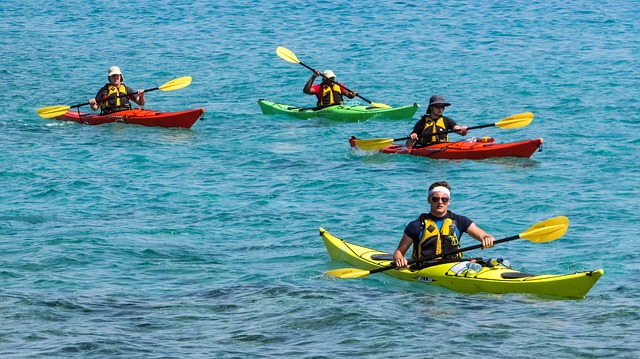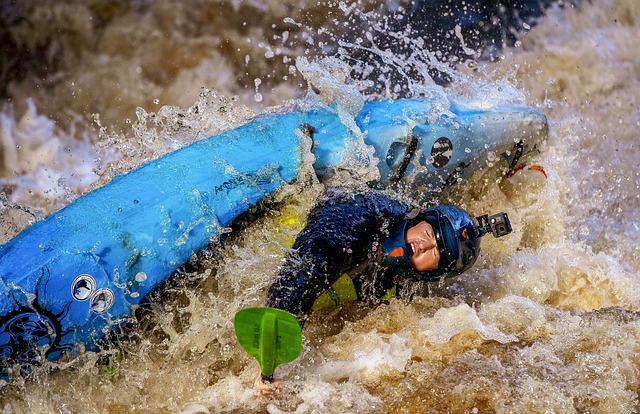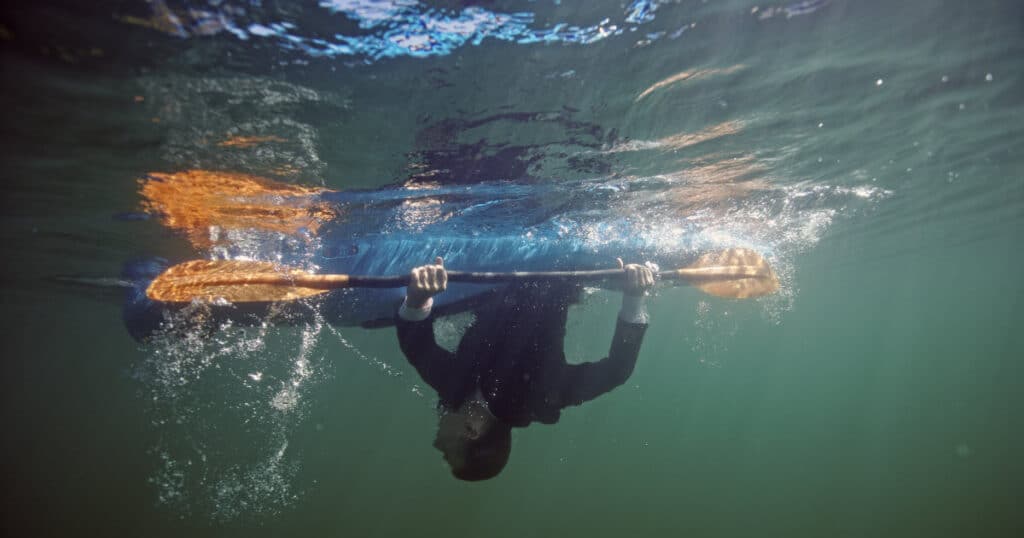One of the most common fears novice kayakers have is that of capsizing and falling into the water. If this is a topic that is causing you anxiety as you plan your kayaking adventure, you’ve come to the right place. In this article, we’ll go over what you need to do if your boat capsizes. It’s important that you know how to do a kayak wet exit, as not knowing the correct procedure could lead to a dangerous situation in which you could be trapped under the boat.
When and How to Wet Exit a Kayak
If you feel that your kayak is about to capsize, you need to brace to try to prevent it from happening.
If you end up capsizing anyway, do your best to keep hold of your paddle, draw in a breath of air, and lean forward.
Next, move your hand along the cockpit coaming in the direction of the grab loop and pull on it. Place your hands on the sides of the cockpit and put your knees together. This is important, since you might be immersed underwater and proper positioning will either aid you in exiting your kayak, or prevent you from doing so.
Finally, you will need to propel yourself forward and allow your life jacket to fulfill its function.
Learning How to Do a Wet Exit with an Instructor
The necessity of learning about the proper way of doing a kayak wet exit is just one reason you should take lessons with an experienced instructor before going on your kayaking trip. During your lessons, you should practice the wet exit in a controlled and supervised environment.

Your instructor should also teach you how to brace to try to prevent your kayak from capsizing in the first place.
Keeping a cool head while underwater is essential for a safe wet exit. Practicing with a pro will allow you to gain experience and become comfortable if you do flip your kayak.
Many instructors make teaching the wet exit a top priority in their kayaking courses. One reason for this is the fact that it not only makes students safer but gives them confidence.
You will probably feel quite anxious when getting ready to practice doing a kayak wet exit. This is understandable. After all, you might fear finding yourself stuck in the kayak’s cockpit when underwater. As long as you’re taking a reputable course with a qualified instructor who will supervise everything as it should be, you will be fine.
Ask your instructor what you should wear and any clothes you should bring to class on the day you do the wet exit exercise. This is important because you don’t want to end up getting a chill from being soaking wet for the rest of the class. Hopefully, you will take your class in a heated pool. This tends to be the most comfortable and convenient option.
Important Tips for the Wet Exit
It’s crucial that you protect your head from anything underwater when doing the wet exit.

This is why leaning as much as you can towards the front deck is so important. Get in the closest possible proximity to the front deck as you can. When you lean forward, you will also be more effectively positioned to reach the grab loop. The grab loop is located on your spray skirt. Always remember that the closer you get yourself to the deck, the further you’ll be from anything that could act as an obstacle beneath the water.
It’s when you’re upside down and your head is under the water that you’re doing the tucked forward position. If you don’t like getting any water up your nose, you should try to slightly exhale a tiny bit of air through your nose. This will help stop the water from making its way in.
While you’re in the cockpit, before becoming submerged in the water for the exercise, you should do certain stretching exercises. Do ten forward leans, going as far forward as you possibly can with these. Always hold the forward lean position for a few seconds before you stop.
When you feel that you’re probably going to capsize, it’s commonly recommended that you get into the roll position. This is the position that many instructors use for a wet exit.
Reaching the Grab Loop
You will need to reach and hold your grab loop when you’re in the upside down and leaning forward position. The grab loop is generally in the front area of your cockpit coaming. You should never depend completely on your eyesight to locate the loop. Instead, you should be able to find it completely by feeling around.
You might have some difficulty directly reaching for the loop’s end. This is because most grab loops are made to be flexible. To deal with this issue, when leaning forward you should use your free hand and its thumb to feel the edge of the skirt. Then move your hand in the direction of the front of the coaming. This will help you locate the grab loop’s base. When you do this, you should be able to feel coaming between the index finger and thumb.
Your other hand will be holding the paddle. With practice, you’ll have the chance to discover which hand is most effective for getting the skirt detached from the coaming. Remember that one hand holds the paddle shaft while the other reaches for the loop.
Always Have Contact With Your Paddle
You must always have contact with your paddle as well as your kayak. If you don’t, you risk losing them when doing the wet exit. If you’re dealing with water that has strong currents or there are strong winds in the forecast, your kayak and paddle could move away from you very rapidly, creating a dangerous situation.
Once you’ve located the grab loop, you need to get a very strong grip. This is essential so that you can detach the skirt from the coaming. Grab loops are commonly wide nylon straps in a loop shape. You should keep your thumb on the outside of the loop while all four fingers are within it. Remember that no matter how you take hold of the loop, you must have a strong grip.
A Sit-on-Top Kayak Can Be a Better Choice for Beginners
If a sit-on-top kayak capsizes, then you will simply fall out. It’s when you’re in a sit inside model that you end up having to do the full wet exit procedure. This is why if you’re a beginner, you’re probably better off going with a sit-on-top kayak.

Other Tips for Doing a Wet Exit
Whether you choose to practice a wet exit on shore or in water, make sure someone is there with you. If you’re doing the wet exit practice in water, then you should be under the supervision of a qualified kayaking instructor.
Don’t panic! You must stay calm while under the water when doing a wet exit. Getting out of a kayak under the water is actually very easy if you know what to do and don’t panic. It’s normal to feel nervous the first time you try a wet exit. Do your best to keep a level head. Kayaks are designed so you can get out when you flip your craft … you just have to know how.
Remember that it will only be a few seconds from the time you submerge to performing your wet exit. You will probably feel like you’re under the surface longer than you actually are, especially the first time you try a wet exit.


